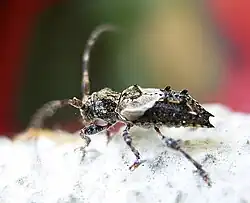Pogonocherus hispidus
| Pogonocherus hispidus | |
|---|---|

| |
| Scientific classification | |
| Kingdom: | Animalia |
| Phylum: | Arthropoda |
| Class: | Insecta |
| Order: | Coleoptera |
| Suborder: | Polyphaga |
| Infraorder: | Cucujiformia |
| Family: | Cerambycidae |
| Genus: | Pogonocherus |
| Species: | P. hispidus
|
| Binomial name | |
| Pogonocherus hispidus | |
| Synonyms | |
| |
Pogonocherus hispidus is a species of beetle in the family Cerambycidae. It was described by Carl Linnaeus in 1758, originally under the genus Cerambyx. It has a wide distribution throughout Europe and North Africa. It contains the varietas Pogonocherus hispidus var. rufescens.[1]
P. hispidus feeds on Cornus sanguinea, Corylus avellana, Ilex aquifolium, Hedera helix, and Euonymus europaeus. It serves as a host for several parasitoid wasp species, including Dolichomitus agnoscendus, Eurytoma morio, Ephialtes manifestator, Lestricus secalis, and Cenocoelius aartseni. It measures between 4 and 6 mm (0.16 and 0.24 in).[1]
References
- ^ a b BioLib.cz - Pogonocherus hispidus. Retrieved on 8 September 2014.